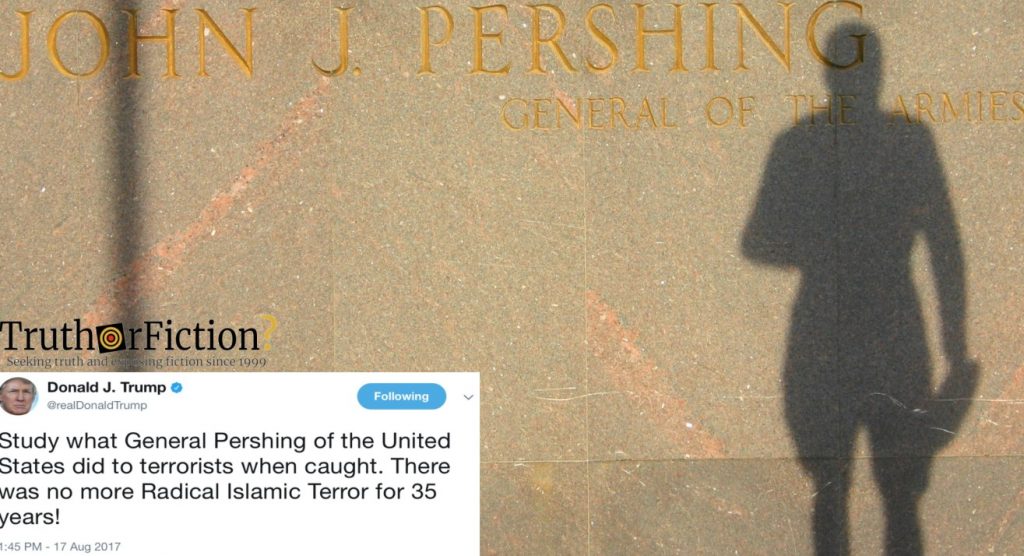In both his presidential campaign and his one term in office, Donald Trump leaned on a debunked tale of anti-Muslim brutality to further endear himself to right-wing Americans.
As several outlets reported in February 2016, Trump invoked the story of U.S. Gen. John J. Pershing at a campaign rally in South Carolina while painting the use of waterboarding as “minimal torture.”
In the speech, Trump and his supporters endorsed the alleged execution methods Pershing used after the U.S. occupied the Philippines:
They were having terrorism problems, just like we do. And he caught 50 terrorists who did tremendous damage and killed many people. And he took the 50 terrorists, and he took 50 men and he dipped 50 bullets in pigs’ blood — you heard that, right? He took 50 bullets, and he dipped them in pigs’ blood. And he had his men load his rifles, and he lined up the 50 people, and they shot 49 of those people. And the 50th person, he said: You go back to your people, and you tell them what happened. And for 25 years, there wasn’t a problem. Okay? Twenty-five years, there wasn’t a problem.
In August 2017 — after being elected president despite losing the popular vote — Trump again held up Pershing as an example in response to a terror attack in Spain. Trump wrote on Twitter, “Study what General Pershing of the United States did to terrorists when caught. There was no more Radical Islamic Terror for 35 years!”
Trump going from “25 years” to “35 years” in repeating the story is a sign that, as with a lot of what he says in general, he was pushing disinformation. There is no evidence that Pershing ordered such an attack.
Following Trump’s tweet, the Chicago Tribune reported that one of its own correspondents might have been the original source for the anecdote; according to the newspaper, Capt. Herman Archer’s story on August 21 1927 contained mention of a “well-known” story saying that Pershing sprinkled pig’s blood on prisoners before releasing them:
“Then [Pershing] announced that any Juramentado thereafter would be sprinkled with pig’s blood,” Archer wrote. “And those drops of porcine gore proved more powerful than bullets.”
The correspondent does not seem to have personally witnessed this incident, but seems rather to be relaying a war story shared with him by others. No mass executions were reported by the Tribune, and the copy is peppered with characterizations of Muslim Filipinos as “savage sultans” and “devilish brown men” that make anyone with modern day racial sensibilities bristle.
The story has been further debunked by historians who studied Pershing’s efforts before his stint as campaign fodder. As The Washington Post reported in August 2017:
Brian M. Linn, a history professor at Texas A&M University, did just that nearly two decades ago when he published “Guardians of Empire,” a book on the U.S. military presence in Asia from 1902 to 1940.
His verdict on Trump’s claim?
“There is absolutely no evidence this occurred,” he told The Washington Post.
“It’s a made-up story. It doesn’t seem to matter how many times people say this isn’t true. No one can say where or when this occurred.”
Pershing himself made no mention of using pig’s blood to kill prisoners in his memoir My Life Before the World War, 1860-1917, nor in his other writings. However, he wrote that U.S. troops did use pigs to reduce attacks by Muslim fighters in what was then called the Moro Province by offending their religion.
“The bodies were publicly buried in the same grave with a dead pig,” Pershing wrote. “It was not pleasant to have to take such measures, but the prospect of going to hell instead of heaven sometimes deterred the would-be assassins.”
Neither is there a mention of blood-tipped bullets in Black Jack: The Life and Times of John J. Pershing, the 1977 biography of the general that was a finalist for the National Book Award.
Another book, The Encyclopedia of the Spanish-American and Philippine-American Wars, which was published in 2009, does note that Pershing showed some leniency to prisoners after a standoff with local Muslim fighters (referred to as “Moros”) resisting an order to give up their weapons:
Pershing reported 300 Moros taken prisoner. Casualties for the entire campaign on the American side were 3 wounded. One the Moro side, 12 were killed a few others wounded. Pershing sent the prisoners to Mindanao to be tried for insurrection. Later he decided to drop the charges if a prisoner’s friends could collect sufficient arms for his release.
Business Insider further reported that the family of Pershing (who went on to command U.S. troops in Europe during World War I) not only debunked Trump’s claim that he used the blood-tipped bullets, they called his habit of lying “appalling.”
“He was one of the greatest generals we’ve ever had,” said Pershing’s great great granddaughter Hollis Taylor. “He was the only American to be promoted in his own lifetime to the Army’s highest possible rank. And he didn’t get there by bullying people.”
Update 5/6/2022, 3:24 p.m. PST: This article has been revamped and updated. You can review the original here. — ag
- Trump Tells Story About Killing Terrorists with Bullets Dipped in Pigs' Blood, Though There’s No Proof Of It
- Trump's Discredited Ppig's Blood Tale May Have Roots in Tribune Story from 1927
- Trump Said to Study General Pershing. Here's What the president Got Wrong.
- The Encyclopedia of the Spanish-American and Philippine-American Wars
- Trump Keeps Repeating an Ugly Myth About a Revered US General — And one of His Last Living Relatives Says It's 'Appalling'

